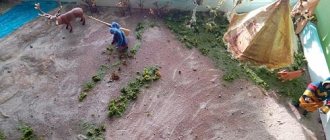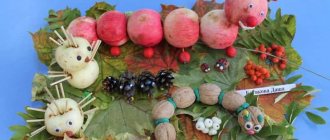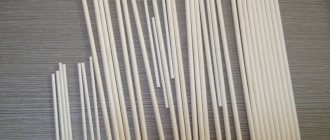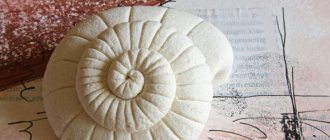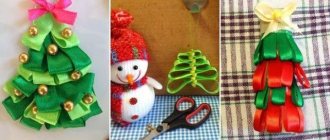Boys of all ages love to play with soldiers. What game can there be without weapons, cars and special equipment? Of course, the soldiers will also need parachutes. So, how to make a parachute out of paper? From a simple leaf you can create three types of parachute: umbrella-shaped, standard quadrangular and with one propeller. You can make any of them, whichever seems more beautiful. Small umbrellas are suitable for toys; for equipment you will need to create something more voluminous and impressive.
Light parachute
To create it you will need thin paper, sharp scissors, some thread and special glue. Such a parachute from sheets is created in the following way:
- Take a white or multi-colored leaf. Using glue and small pieces of paper, glue a thread of identical length to each corner of the sheet.
- All 4 ropes are tied into a knot almost at the very bottom, and a cardboard square is attached or glued to their ends.
- The last stage: you need to bend the product first along one diagonal, then along the other, to create edges. That's it, the parachute is made, you just need to throw it into the air, where it will begin to open on its own.
Paper craft
It’s worth starting with a simple product. A simple paper parachute is very easy to make. To work you will need the following:
- Thick napkin and paper sheet.
- Strong threads for knitting.
- Gingerbread toy.
- Scissors.
Take a napkin or cut out a square from a prepared paper sheet. From the main skein of thread, cut four pieces thirty centimeters long. Tie the resulting threads to each corner of your paper square. Tie the remaining loose ends with a knot. Cut another piece 15 cm long from the skein of thread and tie it to the already created knot. Using an auxiliary thread, tie on your parachutist (kolobok). This beautiful parachute is ready for play.
Umbrella parachute
How to create a product if you want to do something unusual? To do this, you will need to acquire auxiliary materials. You will need the same scissors, a small stick about 30 centimeters long and no more than a centimeter in diameter, paper rings, thread, paper or light material (silk will do). Step by step creation:
- First, you should glue a paper ring onto the stick, placing it on the border of the upper third of the entire length of the object.
- Then you need to glue a second ring with a huge diameter so that it can move smoothly. It is to it that future cables - threads - are attached. In order for them to hold well, you need to create a third ring and attach it on top.
- Next, an even circle is cut out of the material, its center is attached with a pin to the end of the stick.
- The main cables need to be attached around the circumference of the entire parachute.
How to sew a parachute for games with your own hands, pattern
If your daughter or granddaughter has a doll, then sooner or later there will be a need to update her wardrobe. As a rule, funds for updating a doll's wardrobe are not separately provided for in the family budget, and ready-made doll clothes cost almost the same as real children's clothes. There is only one way out: sew clothes for a children's doll with your own hands. You can create a doll's wardrobe relatively inexpensively if you use budget options for finding sewing materials.
1. It is very convenient to sew clothes for small dolls from socks. Thanks to its high elasticity, it is easy to put on and fits the doll's figure well. A pair of socks can make a great set.
2. Handkerchiefs give a lot of room for creativity. Firstly, they already have a neatly processed edge, and secondly, they often have a very interesting pattern.
3. For small dolls, interesting clothes can be sewn from satin ribbons. For children under three years old, do not forget to not only burn the sections, but also trim them with thin thread.
4. Clothes your child has outgrown are good material for updating a doll's wardrobe. The color scheme has already been selected, the appropriate trim just needs to be carefully torn off, you can creatively use the processed edges of former clothes, existing embroideries and appliqués. But there is a nuance - you must obtain the child’s consent to recycle his things.
5. An excellent place to look for material for doll clothes is “Everything for 39” stores (the price may be different). Bolognese aprons make excellent raincoats and jackets, a small terry towel makes a bath set, and neckerchiefs make elegant dresses.
6. Interesting materials can be found at sales. It often happens that a thing in the form in which it is manufactured and sold is not in demand. However, the material and finished finishing can be perfect for doll clothes.
7. An old bag or cosmetic bag will be useful for making shoes, belts, bags and other accessories.
8. You can buy beautiful scraps inexpensively at a sewing studio. Small scraps for small dolls can sometimes be obtained from the studio for free.
Sewing clothes for a doll with your own hands is interesting not only for adults, but also for children. Very often, the idea of one or another model is born in the process of examining an existing scrap. This is very useful for developing a child's imagination. Even if your daughter is too young to work with a needle, she may be interested in the process of creating clothes for a doll.
Product with propeller
There are also unique types of equipment. For example, a parachute with a propeller. This model is one of the most difficult. To create it, you need to take a simple nylon stocking, a small steel wire and a standard softer wire.
The steel part is bent into two parts, and then these parts are bent in the form of an arc. The ends need to be crocheted. A soft part must be wound around the ends of the wire.
The curved part of the arches must be wrapped with nylon. From paper you need to make a flag and a figurine of a soldier who will descend with a parachute. All that remains is to make a sling, with which you can launch the created parachute.
“Magic Parachute” - a universal play aid during the adaptation period of young children
“Magic Parachute” is a universal play aid during the adaptation period of young children.
A play parachute is a bright fabric consisting of several colored sectors, with handles located in a circle.
Playing with a parachute is a tool for psychologists and teachers to monitor children during the period of adaptation to preschool educational institutions, correcting visible violations of the communicative, emotional-volitional and cognitive spheres.
A parachute gives a child a rich range of new sensations: a bright visual image, a strong wind, and the feeling of soft fabric hugging a child sitting under a parachute. The “Magic Parachute” is so attractive in itself that usually children do not have to be persuaded for long - they themselves rush towards it as fast as they can. Even very shy children who have difficulty getting involved in general games love to play with a parachute. For quiet and shy children, the parachute provides many opportunities to gradually join the group of children. After all, in games no one requires you to immediately give your hand to other children, as in a round dance, or immediately enter the circle. Each child can choose their own speed and level of activity. This game guide is very useful for both quiet and slow children and active, including hyperactive children, since games with a parachute make it possible to “stir up” quiet children and calm down especially nimble ones. Active children, playing with a parachute, will learn to follow the rules of the game, wait their turn, and interact with each other. The parachute provides a lot of opportunities for playing with rules, playing with boundaries. During the participation of children in collective games and play exercises using the “Magic Parachute” manual, a special environment is created that requires children to be able to coordinately solve problems of a motor nature, obey certain rules, use well-known movements in accordance with game situations, and also independently find different ways to complete the task, come up with new games, game options and rules for them. The main structural unit of parachute training is composition, that is, motor exercises that are continuous in technique and continuous in content, which are combined into a complex. You can send soft, quiet ripples along the surface of the parachute, or noisy and stormy waves, depending on what goal we are pursuing. Games with it teach coordination of actions, the ability to sense the movements of other players, listen to instructions from an adult, and contribute to the development of attention and coordination. Playing with a parachute strengthens the muscles of the shoulders, forearms and hands, which has a positive effect on children's development. By creating giant waves with a parachute, children improve their motor perception skills and develop a sense of rhythm. This game relieves mental stress, liberates the child, creates the prerequisites for establishing contact with other children, and promotes the development of imagination. From the experience of working with this manual, we can say that a parachute provides incomparable assistance in bringing a child into contact with society and helps him independently penetrate into it. Card index of games with a parachute
Game “Greeting” Children sit on the carpet, stretching their legs forward under the parachute, and hold the parachute. Raising the parachute as high as possible, we say “hello” and “good morning” to each other. Game “Sparrows” Age:
from 1.5 years
Purpose:
To evoke in children an emotionally positive response to the game action.
Adults raise and lower the parachute, and under it children sparrows jump on two legs, flapping their wings. When the command “fly out quickly” sounds, all the children run out from under the parachute, and then on the command “Sparrows, go home!”, they must “fly” into the house, i.e. be under a parachute. The parachute can be lowered: night has come and the sparrows have gone to bed. Then the game starts again. Among the white doves, a gray sparrow jumps. Among the white doves, a gray sparrow jumps. Sparrow-bird, Gray shirt, Fly out quickly! Run out, don't be shy! They flew, circled, and came back. Game "Waves/Flame" Age:
2-7 years.
Goal:
to liberate children, develop coordination of movements, attention, develop a sense of rhythm, relieve neuropsychic tension.
This game is suitable for any age. It helps both activate the group and calm it down. We start with small waves/sparks, then we swing the parachute more and more, creating a storm/fire. Then we gradually reduce the waves/fire, saying that the wind/fire has become weaker, the waves/sparks are subsiding/extinguishing, and the sea is calm. You can replace words with music. Loud or fast music – strong waves/fire. Quiet or slow music – weak waves/fire. Game "Entertainers" Age:
2-7 years.
Goal:
development of auditory and visual attention;
activation of motor skills; formation to hold a beautiful static pose. An “entertainer” is selected. Children walk in a circle, hold the parachute (first with their right hand, then with their left hand)
and say the words: In an even circle, one after another, We walk step by step.
Stand still, let's do it together! At the end of the words, the children stop, copy the movement shown by the “entertainer,” and try to “hold it.” Game “Magic Dream” Age:
from 1.5 years
Purpose:
Relieving psychomuscular tension.
3-4 adults slowly inflate the parachute and lower the parachute, while the children lie “daisy-like”. The eyelashes drop... The eyes close... We rest calmly... We rest calmly... We fall asleep in a magical sleep... We breathe easily... evenly... deeply... Our hands are resting... Resting... falling asleep... Relaxing... falling asleep... The neck is not tense and relaxed... The lips open slightly... Everything is wonderfully relaxed ... Everything is wonderfully relaxing... Breathing easily... smoothly... deeply (Long pause. Children come out of the “Magic Sleep”)
We rested calmly, fell asleep in a magical sleep... It’s good for us to rest!
But it's time to get up! Let's clench our fists tighter. Raise them higher Stretch! smile! Everyone open their eyes and stand up! Game "Mushroom" Age:
from 2 years.
Goal:
Relieve emotional and muscle tension.
Everyone holds on to the handles of the parachute and smoothly lifts it three times, and on the third time everyone, without releasing the handle, goes inside the parachute, and it smoothly falls on top of everyone. The breeze is blowing and blowing, Come under the fungus! Game “Flies - does not fly” Age:
from 2 years
Purpose:
Development of reaction speed and thinking.
All players hold onto the edge of the parachute and walk in a circle. The instructor names flying objects, such as an airplane, a bird, a butterfly, a beetle, etc., and the players raise their arms up, inflating the parachute above their heads. In other cases, you need to sit down. Game "Who's under the parachute?" Age:
from 2 years
Goal:
Development of auditory perception.
Children walk in a circle, saying words; the leader in the center, under a parachute, recognizes the one who called. “... you are now in the forest, we call you - AU! ... don’t yawn, find out who called you!” Game “Three Bears” Age:
from 1.5 years
Purpose:
Creating a favorable psycho-emotional state, performing movements in accordance with the text.
3 bears were walking home (children walk in a circle with a parachute)
Dad was big, big
(the parachute is raised up)
Mom and him were smaller
(hands with a parachute at chest level)
And the son was just a little baby
(crouches, lowering the parachute)
He is very small was, Walked with rattles
(the parachute is rhythmically raised and lowered)
Ding - ding!
Game “Spring” Age:
from 2 years
Goal:
Development of speech, the ability to move rhythmically in accordance with the text.
Sunshine, sunshine (they walk in a circle, carrying a parachute)
Golden Bottom Burn, burn clearly So that it doesn’t go out A stream ran in the garden
(they run in a circle, holding a parachute)
hundred rooks flew in
(raising, lowering the parachute)
And the snowdrifts are melting, melting
(slow squat)
And the branches grow
(climb up the parachute) Game “Magic Bubble” Age:
3-7 years.
Goal:
emotional release.
the parachute canopy (“bubble”)
as much as possible
(we raise our arms up)
, with the word “bang!”
(we scream loudly)
- they blew it away.
Game "Space Travel" Age:
3-7 years.
Goal:
to liberate children, unite the group, develop coordination of movements, attention, develop a sense of rhythm, relieve neuropsychic tension.
The presenter introduces the children to two characters who need to be launched into space by a rocket. The parachute is lowered, the children are waiting for the adult's command. “3-2-1-launch!” (loudly, we all pronounce the command together)
.
We raise the dome sharply upward - the hero flies into space! This game causes a strong surge of emotions in children. Game "Bugs" Age:
2-7 years.
Purpose:
relaxation, psychological study.
3-4 adults inflate the parachute, while the children lie like a daisy. The parachute rises. At the moment the dome lands, the “bug” children move their legs and arms chaotically. Game “Terem-Teremok” Age:
from 2 years.
Goal:
relieving psycho-emotional stress. 3-4 adults inflate the parachute and say: “Terem-terem-teremok, someone lives in the little house...” It began to rain: drip-drip-drip. The children are hiding in the house. In conclusion, I would like to note that the proposed games using the “Parachute” manual contribute to the favorable adaptation of children, help the psychologist and preschool teachers correct emotional disturbances in the child. Children's general emotional background significantly increases; anxiety level decreases; cognitive and gaming activity and level of interaction with peers increases; The time frame for psychophysical adaptation is reduced, and adaptive capabilities are strengthened. Games develop the ability to feel and understand others, show interest in peers, help create a friendly atmosphere in the group, mutual assistance, trust, cohesion, friendly and open communication with each other and with adults, facilitating the process of joint learning.
We recommend watching:
Training session for children 9-12 years old Children's theft Seminar for teachers of preschool educational institutions Why do children swear?
Similar articles:
Infancy. Characteristics and features of mental development
Early age. Features of development and leading activities of this age
Preschool age. General characteristics briefly
Cool system of education and development of children. Montessori classes
Educational and play areas. Creating a learning and play area for a child
Whatman paper products
Once you understand how to make a parachute out of paper, you can quickly learn how to create more beautiful models. For one of them you will need a piece of whatman paper, pencils or light paints, sharp scissors and threads, a simple plate and a soldier who will fly with it. First, a plate is outlined on a piece of paper.
It turns out to be a simple circle, from which you need to cut out a sector of fifteen degrees. Now that the blank has been created, you can decorate it with various designs or patterns. The brighter the better . When everything is dry, you need to create four holes around the entire circumference, and glue the circle itself so that a dome comes out. You should thread the cables into the cut holes, tie them in a knot, and wrap them around the soldier figurine. That's it, you can start.
A little tutorial on how to make a small parachute for a little skydiver
© Collage Chips Journal
Great fun for kids and their parents
A little tutorial on how to make a small parachute for a little skydiver
For a great way to add some variety to role-playing with your child or just have fun, here's a tutorial on how to make a tiny parachute from scrap items!
You will need:
- a large table napkin (so colorful and beautiful that you save it for holidays),
- thin transparent tape
- hole puncher
- wool thread
- scissors
- the desperate skydiver himself (this could be a Lego man or any other toy of a suitable shape and size).
Procedure:
1. Cut four identical pieces of thread (about 30 centimeters long)
2. Unfold the napkin and strengthen its corners - stick several strips of tape on the corners of the napkin.
3. Use a hole punch to make holes, one in each corner.
4. Thread the threads through the holes made and tie them.
5. Then tie the threads in pairs together so that there are tails 10-15 centimeters long.
6. On the remaining ponytails, tie two more knots at a distance of a centimeter to create loops for the parachutist’s hands.
7. Put a parachute on your brave hero.
8. And... forward! (More precisely down).
Skydiving can be part of the plot of your role-playing game, or you can simply make several colorful parachutes and launch brave heroes from the height of a closet or dad's height.
Source
What is so wonderful about the cartoon “pieces of paper”
This cartoon is interesting, informative and educational. The main advantages of the cartoon:
- The episodes are fast, one lasts only five minutes - the strain on the children’s eyes will not cause harm.
- Each series includes a master class on creating paper products. Such hobbies develop the child’s fine motor skills and contribute to their full development.
- The cartoon gives inspiration to children.
Of course, I want to make the cartoon characters themselves, because their story is memorable. To create them you will need thick multi-colored cardboard and felt-tip pens to make the faces. From a blue leaf you can make the main character - Aristotle the smart moose. If you want to amuse your child, then after creating a cartoon character, you can start voicing him.

